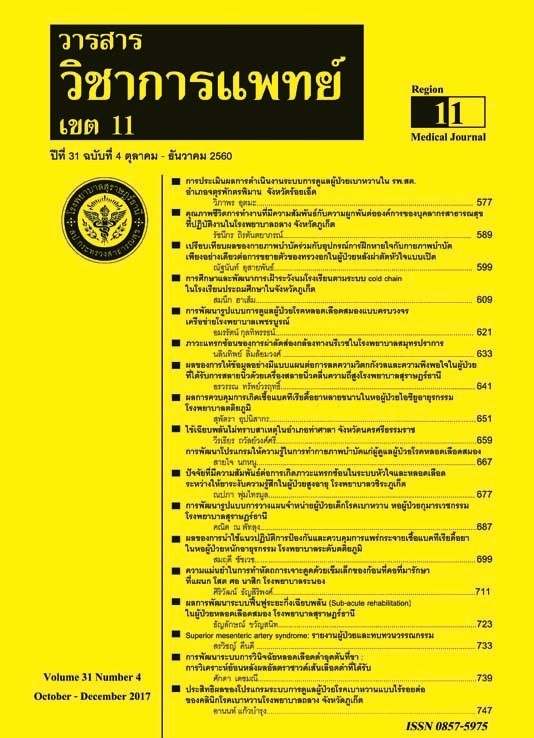Outcomes of Sub-acute rehabilitation program in stroke patient, Suratthani hospital
Keywords:
Sub-acute, rehabilitation, strokeAbstract
Objective : To evaluate the outcome of the sub-acute rehabilitation program in stroke patients. Method : Using a retrospective analytic design to evaluate the outcomes of Suratthani hospital’s Stroke Units patients before and after the introduction of the Sub-acute rehabilitation program.
Result : There was no statistical difference in the demographic characteristics between the two groups of patients except for discharge type. The number of patients receiving the rehabilitation service during admission was roughly the same, i.e. 53.8% and 56.6% respectively but statistically differed when comparing rehabilitation post-discharge, i.e. 12.2% vs 46.4% (p-value <0.001). The Barthel index (BI) was recorded after the development of Sub-acute rehabilitation program and showed 48.3% of patient was severely dependent in activity of daily living (ADLs) to moderately dependent in ADLs (BI 0-70 score). The BI was significant increase during follow up (Mean, SD = 56.59, 34.77) when compared with BI before discharge (Mean, SD =44.49, 27.78), (Mean diff = 12.1, p-value= 0.026).
Conclusion : The introduction of the Sub-acute rehabilitation program significantly increased the number of people receiving post-discharge rehabilitation service.
References
2. คณะทำงานโครงการพัฒนางานการดูแลผู้ป่วยระยะฟื้นฟู (Subacute Rehabilitation) พศ.2558-2559 สมาคมเวชศาสตร์ฟื้นฟูแห่งประเทศไทย. การพัฒนางาน การดูแลผู้ป่วยระยะฟื้นฟู (Subacute Rehabilitation) และถอดบทเรียนการดำเนินงาน ในสังกัดกระทรวงสาธารณสุข; 2559.
3. อรทัย เขียวเจริญ, ศุภสิทธิ์ พรรณารุโณทัย, วัชรา ริ้วไพบูลย์, ชัยโรจน์ ซึงสนธิพร. การพัฒนาการจัดบริการฟื้นฟูสมรรถภาพทางการแพทย์สำหรับผู้ป่วยระยะกึ่งเฉียบพลันและไม่เฉียบพลันในระบบหลักประกันสุขภาพถ้วนหน้าของประเทศไทย. วารสารวิชาการสาธารณสุข;2558; 24(3): 493 - 509
4. Songchai Chinwatanakul, Kanokwan Boonyapisit, Darakul Pornsriniyom, Naraporn Proyoonwiwat, Vorapan Senanarong, Rungsan Chaisevikul, J Med Assoc Thai; 2012; 95 (Suppl. 2): S235-S244
5. รัชวรรณ สุขเสถียร. การเข้าถึงบริการเวชกรรมฟื้นฟูโรคหลอดเลือดสมองระยะ เฉียบพลันแบบผู้ป่วยใน ณ โรงพยาบาลมหาราชนครราชสีมา : ปัจจัยที่เกี่ยวข้องและผลลัพธ์. เวชศาสตร์ฟื้นฟูสาร; 2557; 24(2): 37-43
6. พรพิมล มาศสกุลพรรณ, ทิพยรัตน์ ศฤงคารินกุล, กาญจนา ริ้วทอง, พรทิพย์พา ธิมายอม,พรพิมล วิเชียรไพศาล. แนวทางการฟื้นฟูสมรรถภาพผู้ป่วยโรคหลอดเลือดสมอง (Clinical Practice Guidelines for Stroke Rehabilitation).ฉบับปรับปรุงครั้งที่ 3. บริษัท ธนาเพรส จำกัด; 2559.
7. ปิยภัทร เดชพระธรรม, รัตนา มีนะพันธ์, ประเสริฐพร จันทร, สมลักษณ์ เพียรมานะกิจ, เสวลักษณ์ จันทรเกษมจิต, อำไพ อยู่วัลย์. ความน่าเชื่อถือของแบบประเมินบาร์เธลฉบับภาษาไทยในผู้ป่วยอัมพาตหลอดเลือดสมอง. เวชศาสตร์ฟื้นฟูสาร 2549; 16(1): 1-9.






